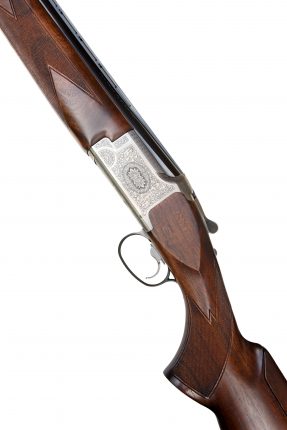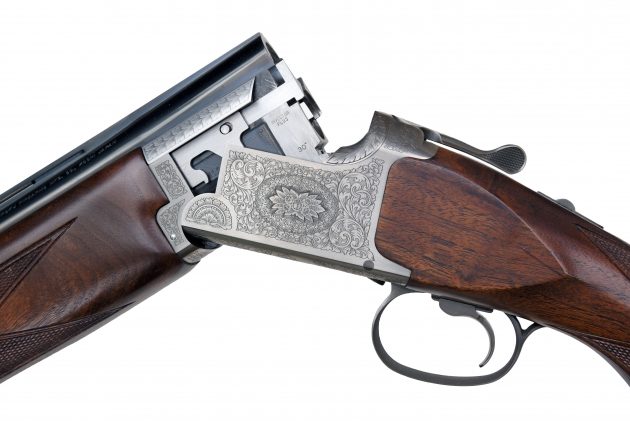Built by one of the world’s great sporting shotgun manufacturers, the Miroku MK38 Sporter may be intended for clays but its potential in the field is almost limitless, as Michael Yardley discovers
Miroku MK38 Sporter review
We look at a Grade 3 30in Miroku MK38 Sporter. Featuring Teague multichokes and 3in chambers proofed for steel, this competition gun has a single selective, inertia-operated trigger and a 10mm ventilated sighting rib. The comparatively reasonable bottom line is £2,880. Miroku has always offered value for money and enjoys a strong following among experienced shots. Years of reliable service have given it a reputation that belies its price point.
MIROKU MK38 SPORTER REVIEW
Initial impressions are of a solidly made and tastefully decorated gun. Mechanically it is a typical Miroku, but this model is especially well presented. While the MK38 is designated a Sporter, the specification with regard to stock shapes, barrel length and choking would suit clays, pigeons, driven game or marsh. I would certainly not see this as a gun limited to clays. Although it weighs 8½lb, its form and aesthetics make it unusually suitable for all-round use (perhaps with the exception of a walked-up day). It does not look like a clay gun and would prompt no comment in a driven line.

There is no excessive bling but enough well-executed scrollwork to create a deluxe look. A pleasingly engraved action appears noticeably better than that of the Grade 1 model, but there is also a Grade 5 with deeper hand-cut engraving and better wood. The stock, which shows some figure, has a traditional tapered comb and sensible standard measurements: 15in length of pull, and drop at 1½in at comb and 23/8in at heel. The low heel measurement makes sense in an adjustable-comb gun – a wide range of head sizes can be accommodated with it.
A simple but excellent Browning grip shape has long been my pattern of choice. It achieves great purchase – and hence great muzzle control – with even depth and good proportions. No palm swell is required to anchor the hand. It is fundamentally a good shape and size.
The only thing I would question on the test MK38 is the (easily removed) lip to the fore-end. I have never understood the purpose of these. They do not enhance looks, and prevent extension of the front arm (admittedly a bad idea usually, as it may impede swing). A pedant might also question whether a Sporter needs a centre bead on the sighting rib – but it is easily unscrewed (and has long been a feature on Mirokus). Neatly machined, the Invector Plus chokes have a protruding knurled section that facilitates those suffering from ballistic thrombosis (the need to frequently change chokes). The bore is marked at 18.7mm, perfect for competition work with plastic wads but some might say a little open for fibre or felt wads.
Miroku, meanwhile, needs no introduction. It is one of the world’s great sporting shotgun manufacturers. As a youngster, once I had passed the 9mm rimfire and .410 stage, three of my earliest, and fondly remembered, sporting shotguns were Mirokus. I sold my stamp collection to buy the first (a double-trigger over-and-under game gun). The stamps would buy a small house today, while the old Miroku might make £300 or so on a good day, but it was my introduction to serious shooting, so money well spent.
This model has an interesting genesis too. It grew out of the Miroku 800 and 3800 trap and skeet models, which form the chassis basis for modern Sporters. In the meantime, the lighter 600 ORE and 700 models evolved into the 6000 and 7000, and later the MK60 and MK70 field guns. When sporting clays began to become popular circa 1980, some top shots chasing the big prizes on offer started to use trap guns for sporting. Some lowered the combs, some lowered the combs and opened the chokes out, and some carried a shorter-barrelled skeet gun for the closer targets as well.

TECHNICAL
The Miroku action is inspired by the Browning B25, with a different fore-end arrangement. On a B25 the fore-end remains attached to the barrels on disassembly; on a Miroku it does not. It is secured by means of a Deeley-style lifting latch. Early Mirokus had ‘V’ mainsprings but these were replaced by helical springs, simplifying manufacture. Miroku continued with demi-lump barrels, however, until halfway through production of the B425, when it went over to monobloc barrels as seen on the test MK38. The firm makes a good job of it, with near-invisible joints (Beretta may be credited with perfecting the process originally). The modern Miroku, like the modern Browning, still has more handwork in it than the average modern Beretta. Having visited both factories, I was amazed by the sophistication and science at Beretta, but heartened to see so much old-school benchwork still in evidence at Miroku.
SHOOTING IMPRESSIONS
I shot the Miroku having just tested several guns costing much more: it performed as well or better. The trigger-pulls were not quite as good and a little more recoil was noted, but no clays slipped past. The Miroku consistently connected with awkward quartering shots and made short work of standard presentations. The gun had good balance combined with excellent stock shapes. As discussed, the Browning-inspired grip allows you to hold on to and control the gun well. I liked the balance (on the hinge pin) and the reassuring heft of the MK38. The 30in barrels suited it well, but there is also a 32in option. This version gets the aesthetics right. It is intended for clays but would make a good pheasant or duck gun. With 3in chambers proofed for steel shot, it becomes a future-proof ‘do anything’ model offering excellent value.
MIROKU MK38 SPORTER KEY INFORMATION
♦ RRP: £2,880
♦ International Sports Brands, Beechwood House, Beechwood Court, Long Toll, Woodcote, Oxfordshire RG8 0RR
♦ 01491 681830




